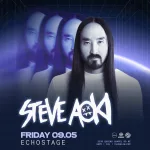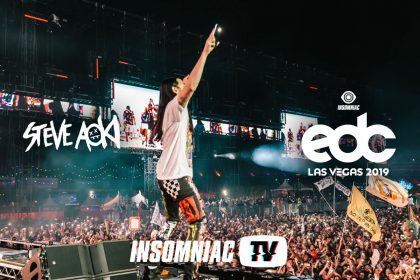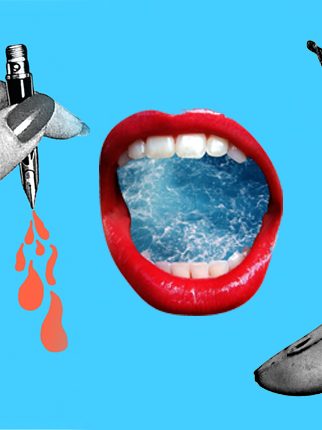Live the Extravagant Steve Aoki Lifestyle Through His New Photography Book ‘Eat Sleep Cake Repeat’
Upcoming Event
One look at Steve Aoki’s Instagram profile will give anyone a serious case of forever FOMO. From cliff dives off the Ibiza coast, selfies with Hollywood celebs, rock stars, rap moguls and DJ royalty, and his trademark Aoki Jumps across every which way in the world, Aoki lives the lavish life many dream of and only a handful get to experience. Wanderlust, thy name is Steve Aoki.
Inspired by his never-ending world travels and daunting performance schedule, racking up more than 250 tour dates per year, Aoki has published his first-ever photography book, Eat Sleep Cake Repeat. The book offers an in-depth look at the Aoki lifestyle like never seen before, captured in over 200 stunning photos that span the past 10 years of Aoki’s life on the road, across the world’s stages, in the studio, in the clouds, and beyond. Eat Sleep Cake Repeat perfectly encapsulates the extravagant Aoki experience and also visualizes all the blood, sweat and tears that go into keeping the Aoki brand alive and thriving on a global scale. From his famed Aoki Naps to the infamous cake tosses, Eat Sleep Cake Repeat captures the true Aoki essence.
We caught up with Steve Aoki and photographer Caesar Sebastian, whose photography is featured in the book, to discuss the story behind Eat Sleep Cake Repeat and the secret trick to capturing the Aoki Jump on camera.

Steve Aoki: I’ve been wanting to do a book for a long time. I’ve been touring at least the last five years with a photographer with me all around the world. It’s a book for the last 10 years because I haven’t done a book yet. There are pictures dating back to when I was playing with DJ AM in L.A., up to everything but my Neon Future Experience Tour. It took a while to select these photos. We had over 1,000 we chose, and there’s only 200-something photos in here. We had to really pick wisely and have a broad spectrum: All the studio shots to different artists I’ve worked with and performed with to all the adventures and the Aoki Jumps in all these different cities and different countries. I travel with maybe five different photographers, who are represented in the book. How they’ve directed these shots is really interesting. There’s a story with each [photo]; I even left the handles with what I wrote on Instagram or on the blog.
Do you feel the book tells the story of Steve Aoki and Dim Mak in full?
Steve Aoki: In select. That’s why were going to do a digital version of the book, where I talk about each photo and tell the story behind it. That way, each photo is a timepiece. This is my first jot into publishing, so it’s actually really exciting to jump mediums. I tell my story though music; that’s what I’m known for. Now I’m able to tell my story through the photos.
You obviously have to trust your photographers to capture the exact image you’re looking for. How did you go about choosing your photographers?
Steve Aoki: Some of it’s like friendships and word of mouth and the photographers themselves being proactive. There are a lot of photographers out there now shooting. Just the same way I’m proactive with my music, they have to be proactive with getting their photos to artists. With Caesar Sebastian, he didn’t have to do that because he was already shooting us for festivals. I remember the first photo Caesar shot of me from 2010 at EDC L.A. with me and a champagne bottle up in the air and Lil Jon. We were doing “Turbulence” for the first time; that was five years ago. Caesar really captured that moment, where you see a sea of 10,000 people and the Coliseum in the background. It’s such an epic shot. Caesar was always shooting around other places, and then he bounced between me and Sonny [Skrillex], back and forth. He ended up traveling more than me and more than Sonny, more than all these DJs. He’s like the most-traveled human being alive.
You’re one of the few artists to successfully become a lifestyle icon. In addition to your music, there’s a Steve Aoki lifestyle. You’re able to give fans and viewers a deep look into your life via your YouTube channel, your Instagram, and all your other social media channels.
Steve Aoki: There are a lot of layers, and as you’re saying, I’m transparent in the majority of these layers. There are plenty of actors that hide themselves. Daft Punk really remain a mystery and only push out their product at a given time that they say so. I really appreciate artists that do that. [It’s] the opposite of the way I do it. In a way, the idea of reveling in your vulnerability is a very scary concept. But it’s something that if you can do it, if you can face it and smile at it, life is so much better.
Do you ever feel it’s too much? Do you ever feel like you’re putting too much of yourself out there via social media? Or on the other hand, are fans demanding too much from artists nowadays?
Steve Aoki: Fans are always going to demand what they’re going to demand. It’s up to you to decide what you’re going to give them. It’s everyone’s own decision. I don’t think there’s a right or wrong [way of] giving too much away or too little. You could say the same thing about strategies on how to get your music out there more than the other guy. You have to think about who you are in context of the people who actually care about what you do, and then decide. It’s almost like you’re a general making a decision on where your troops are going to go.
Everyone’s got a different opinion or decision on all these things. For me, I don’t really care either way. I actually respect all the different approaches. Kanye [West] was talking about “product”; he always wants to create a product that represents his culture. And that’s essentially a philosophy I live by. A lot of different things inspire me, and I want to create a product that people can actually be a part of this culture, whether if it’s through the new eyewear we just came out with, or a new song, or the new fashion collection launching in Japan—whatever it might be that inspires what we’re doing right now in 2015—and always keep pushing it forward that way.
Any plans for a written biography?
Steve Aoki: Yes, [we’re] in the middle of it, actually, but it’s going to happen. I’ve been writing it, but I need some help, so I’m talking to some people to help me. It’s hard, because I’ve written a lot already, so I’m trying to piece me all together. We’re figuring out how to [encapsulate] my crazy consciousness.
How difficult is it to capture moments like Aoki Jumps and cake throws? Have you ever missed the jump or the cake in the air?
Caesar Sebastian: Cake throws are always tricky, since light design is always different at every show. I love to capture the moment before the impact and the second right after someone gets a full cake-face. Steve’s shows are going 100 MPH—many things happen at once—so keeping an eye open is crucial. As far as the infamous Aoki Jumps, I’ve trained myself to always take the main photograph on the first shot. I’ll take a second photograph just to have it as backup. I’ve never missed a shot.
Steve is a unique specimen. What tricks of the trade do you use to capture the essence of Steve Aoki? Any specific cameras or lenses necessary to capture Steve?
Caesar Sebastian: As far as equipment, I have two Canon 5DMKIII bodies with all prime lenses: 11–24mm, 70–200mm, 35mm, 85mm,15mm and a GoPro HERO4 Silver. If I’m on a boat and Steve jumps from a cliff, I may use the 70–200mm. However, sometimes I manage to get the captain to get really close, and I will end up using a wide so I can capture something so immense and rapid at a very close physical range. Wide lenses also intensify the action. Anything underwater, I mostly use the GoPro; I just have to watch out for jellyfish. When Steve is working out or working on music in the studio, I use my fixed lenses more often. They give you a sense of personal space, and anything below f/2.8 is celestial. For the big festival shows, I use all my lenses, constantly switching around to find the perfect energy.
What importance does location, backdrop, etc. play into capturing the perfect Aoki image?
Caesar Sebastian: One of the first things we do when we land in a different country is to create photographs like the Aoki Jump, Aoki Nap, Zen Aoki, Aoki Style, Aoki Boot Camp, Aoki Cliff Jumps—and during the shows, the Cake Face Series, Aoki Selfies and Aoki Group Shots. The only real challenge, at times, is to find the right location in order to create content that truly stands out on Steve’s social media. Recently, we had a show in Moscow where our flight arrived at 4am. Instead of going directly to the hotel, we spotted a few monuments and made the drivers turn around so we could take photographs. We never really think about jet lag or obstacles; we make the most of the places we travel to.
Along with great shots from festivals and clubs, you often take photos of Steve offstage, which show another side of him. How do you manage to capture the essence of Steve when he isn’t making music or performing? How does that differ from capturing him in the studio and onstage?
Caesar Sebastian: When you tour with Steve, you never really stop shooting. We start early and end late at night with the shows. Even when we are in the hotel room, we will find ourselves shooting. I photograph everything from press conferences, gym sessions, adventures, radio shows, meet and greets, dinners with his friends, music studio, him and his dog, etc. As I said, we maximize our time. He may be jumping off planes in Dubai to jumping off cliffs in Ibiza; I’m always there to capture those moments. He has a good sense of composition as well, so we are always feeding off each other and brainstorming ideas. Lately, I have begun creating a bit more complex images where I use Adobe Photoshop to create composites of him doing abnormal things, like flying into space, levitating, and even turning into Rapunzel (Aoki version).
Steve is one of the few traveling DJs who have made his lifestyle a part of his brand. People want to see the things he sees, to travel to where he travels, to eat what he eats. How do you tell the story Steve Aoki as a lifestyle through images?
Caesar Sebastian: Instagram is huge for us. Every day after we visit a country, we select the best photographs that will tell the story of our day. I also post all the photos on his Facebook, where fans can download them and use them for their social media. It’s always fun to see how many people will find themselves in these photographs and upload them to their Instagram.
What makes a traveling music photographer like you different from other photographers?
My schedule is intense. Last year I did over 250 shows, and not only was I taking photographs for Aoki, but also for Skrillex. Everyone who is on the road with us deserves a huge amount of respect. Getting to know the tour manager, lighting designer, visuals architects, production manager, video guys, and the rest of the team is essential. Creating a good energy between everyone can make or break a tour. Most importantly, understanding the tour codes—like stage etiquette, lobby calls, and doing more than what you’re expected—will get you far. Also, I’m a huge techno fan and have been listening to electronic music for many years. I love the old and the new.
Follow Steve Aoki on Facebook | Twitter
Follow Dim Mak on Facebook | Twitter | SoundCloud
Follow Caesar Sebastian on Twitter | Instagram








